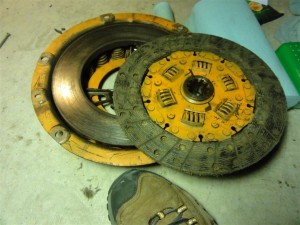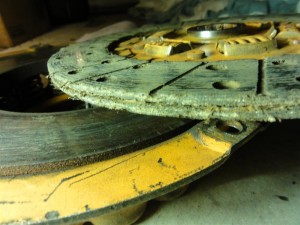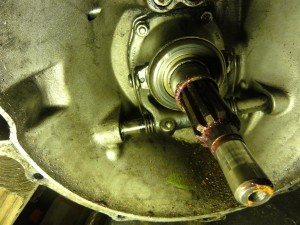
My FX4 Black Cab clutch was slipping so I ordered a new one and on removing the old one, realized that the friction plate looked just peachy. Dismayed, I turned to my dad, Ori and the helpful chaps at KipMotor.com and got myself a whole new list of things to check:
- The friction plate. It may be worn which would be obvious on removal, or the friction material may have been riveted onto the plate too tightly. In the latter case a crushed plate won’t operate as intended and your clutch will slip.
- The gearbox splined shaft may have a notch or burr on it. This would prevent the free movement of the clutch plate to and from the flywheel, and make it fail to engage.
- Grease on the gearbox splined shaft. The KipMotors folk told me not to put any on. When I took my gearbox out, the shaft was slathered with grease. This can get off the shaft and lubricate what should be a dry clutch. Result: slippage.
- Oil leak from the seals on the engine or gearbox. This would allow oil onto the friction plate, making it slippy and unable to harness the 65BHP beast that is the 2.2 diesel engine.
- The thrust bearing on the gearbox shaft may be worn. The carbon should be 3/16″ proud from the surface – it’s a carbon bearing designed to wear in tandem with the clutch, rather than a roller bearing. I don’t fully understand this yet to be honest.
- The levers that operate the clutch in the clutch assembly could be out of adjustment which would cause the friction plate not to fully and smoothly engage with the pressure plate and flywheel. This isn’t something you can see easily, so if in doubt – replace it.
- Sticking master or slave cylinder. If the slave cylinder has any rust, it’s possible for the piston not to move freely and to prevent the full engagement of the clutch. If the master cylinder sticks and doesn’t move far enough back, the hole allowing oil back into the reserve will be blocked. The hydraulic system will then always be under pressure, meaning the clutch won’t be released fully.
- The flexible hose connected to the slave cylinder may be partially collapsed. Under clutch pedal pressure it may allow oil to pass along it, and when the pedal is released, the pipe returns to its collapsed state before the clutch fork is fully released.
- The wrong oil may have been used to fill the hydraulic system which may have caused failure in one of the cylinders. The right oil for your London taxi is discussed previously.

The last three I could have checked without removing the gearbox, but that was an adventure in itself, and one that I have thus far enjoyed. Ori and I McGuivered some real Rube Goldbergesque devices for supporting the gearbox as we removed it from the car. Bits of wood, a furniture dolly, a few jacks and a little bit of Miss Piggying got the gearbox from the car’s underbelly, and now it lies forlornly in the garage, waiting to be reunited with it’s flywheel.
I fear that the random application of leverage and force won’t be as helpful in returning and repositioning the gearbox and friction plate, and that some level of finesse is required. At which point, I’ll probably make a call for more jacks and manpower.

